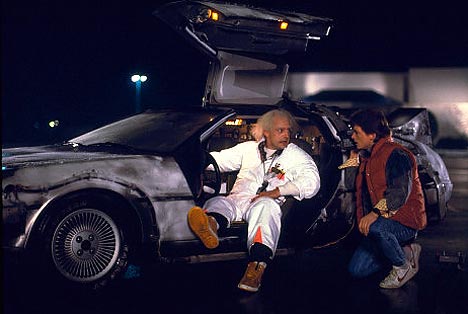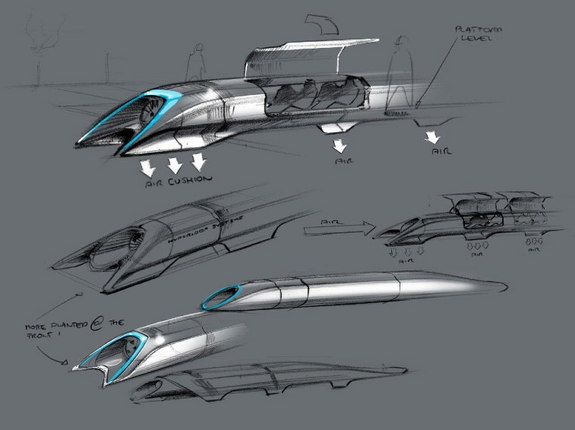In the classic Robert Zemeckis movie Back to the Future, Marty McFly explains to Doc Brown that the Delorean/time machine he (Doc) invented is nuclear-powered 1, and that the only obstacle to sending Marty back to the future (1985) is obtaining some plutonium. I love Doc’s response:
I’m sure that in 1985, plutonium is available in every corner drugstore, but in 1955, it’s a little hard to come by.
The irony in this statement of course being that in spite of sweeping changes to fashions, music, politics – and Marty’s own mother – plutonium is still mercifully difficult to obtain, and the future Doc Brown had to contract with Libyan terrorists to get some. Sometimes the future doesn’t come as fast as we think it might.

At the end of the movie, Doc returns from 2015 having outfitted the Delorean with turbofan VTOL tires and a “Mr. Trash” appliance that generates 1.21 Gigawatts from household food scraps. I haven’t made up my mind as to whether this epilogue continues the irony of the plutonium comment or whether Zemeckis falls into the same trap that he set for Doc Brown, imagining an impossibly technological future. Certainly science moves quickly. The line between tech journalism and science fiction can seem very thin, particularly when we live in a world of synthetic hamburgers and augmented reality. Almost none of my friends had cell phones in high school, and now most middle schoolers seem to. On the other hand, 2015 is sixteen months away, and I don’t see any flying cars or household nuclear reactors.

So what are we as transportation professionals to make of Elon Musk’s Hyperloop? Is this the transport mode of the future, or a literal pipe dream? My first reaction is that Musk seems to have put considerably more thought into the physics of this system than similar proposals, like ET3. Indeed, I think enclosed-tube transportation systems solve lots of the obvious safety issues involved with high speed objects traveling near ground level. If I were to dream up a new mode of transportation, it would probably look a lot like this.
I am an engineer in the loosest sense, and I’m not a physicist at all, so I can’t really comment on the feasibility of the mechanisms. But I can look at the volume calculations. Based on Musk’s design abstract2, the maximum passenger limit of the Hyperloop is 3360 passengers per hour. Certainly in operation the efficiency will be lower as passengers board and alight. If you discount it by 30%, the total volume of the system is roughly that of a freeway lane3, but considerably lower than an intercity rail line. Scaling the system for higher volume routes such as the northeast corridor would only be possible with multiple tubes. This is of course not prohibitive, but it wasn’t mentioned. In all, I think we can pass him on this metric.
More worrying is the discussion of energy use. The “energy per passenger journey” presumably doesn’t include the amortized production energy from the vehicles and the infrastructure.4 With each pod carrying a large battery made of rare or heavy metals and running on a tube made from high-performance steel, it will seem a little less attractive from an energy standpoint. More importantly, I really don’t buy the argument that the steel in the tube and the concrete in the pylons is going to be any less voluminous than the steel rails and concrete ties they are supposed to replace. Musk really needs to run through these numbers again.
Perhaps counterintuitively, the discussion of unsolved problems is where he really goes off the rails.5 Certainly there are problems to be worked out, and Musk acknowledges this. The white paper lists the following unresolved challenges (last page):
- More expansion on the control mechanism for Hyperloop capsules, including attitude thruster or control moment gyros.
- Detailed station designs with loading and unloading of both passenger and passenger plus vehicle versions of the Hyperloop capsules.
- Trades comparing the costs and benefits of Hyperloop with more conventional magnetic levitation systems.
- Sub-scale testing based on a further optimized design to demonstrate the physics of Hyperloop.
These issues are minutely specific, whereas some of the most fundamental ones have not been addressed. He treats the problem of you know, consumer demand for such a system, as given. Of course people want to take the fastest, cheapest option! But human choices are more complicated than that. Intercity mode choice is a function of cost and time to be sure, but people will also pay for comfort, familiarity, convenience, and other attributes. An enormous part of the best econometric models of transportation choice is the appropriate treatment of residual random error.
That Musk hasn’t fully processed the demand equation is evident on the home page, where he says that his system is most appropriate for trips shorter than about 1500 miles, because “Around that inflection point, I suspect that supersonic air travel ends up being faster and cheaper.” Well, London had supersonic commercial air service before it had Lady Thatcher, and there wasn’t enough demand for it to justify updating the Concorde. Musk may blame this on international regulations against overland sonic booms, but there are are plenty of transoceanic routes that should have worked6 except the Concorde’s speed limited its range and passenger volume. Its unique attribute is precisely what made it economically infeasible, and Musk’s inability to recognize this makes me doubt his seriousness.
Besides, why sell himself short? If you count airport-to-city center trips in the time calculation, Hyperloop could beat the Concorde to LA from Atlanta.
But the single thing that shows me this project is not going to be running anytime soon? The thing that shows Musk is a Silicon Valley entrepreneur who mistakenly thinks the world around him is waiting for him to solve its problems, and that if he applies his superior mind to them, they will be? He thinks it will be running in ten years. Great Scot! Good luck getting the EIS approved in ten years, Elon.
Next time: the zombie that is personal rapid transit.
- “No, no, it’s electrical, but I need…” blah, blah ↩
- 28 people per pod, 30 second headways ↩
- With an average occupancy just north of 1.1 ↩
- By the way, Elon, figures for the Tesla Model S needs to start including this energy cost as well. ↩
- This counter-pun is for you, Donny. ↩
- Sydney to Hong Kong, Tokyo to San Francisco, Singapore to Dubai, etc ↩


This idea really should be STATIONed on a shelf somewhere. If they really want to ACELA at this endeavor, the right of way to do it would be to find some STAKEholders. But still – it’s a FUNICULAR idea to think about!
That is truly punishing.